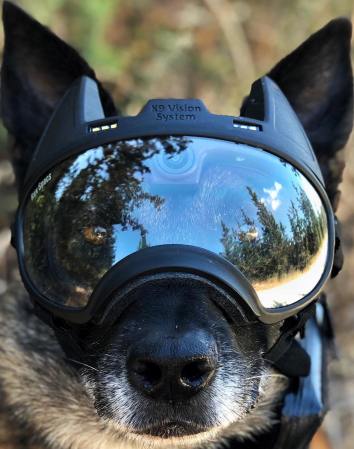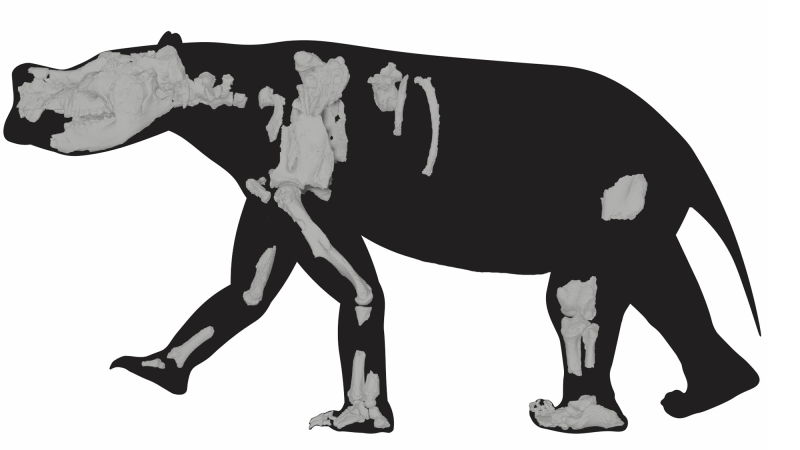

This article was originally published on Undark.
The 911 call came early the morning of April 24, 2020: A man was reportedly at the home where his estranged wife lived, violating the protective order she had against him. Police arrived, spotlighting the backyard with flashlights. Jeffery Ryans, a 36-year-old Black man, stood outside smoking a cigarette.
According to body camera footage, officer Nickolas Pearce ordered him to the ground and warned that if Ryans didn’t comply, he’d release his dog, K9 Tuco. As Pearce and the other arriving officers approached and Ryans dropped to the ground, Pearce commanded the dog to attack: “Hit! Hit!”
“I’m on the ground,” Ryans shouted. “Why are you biting me?”
He continued yelling and screaming, the footage shows. When police cuffed Ryans, face down on the ground, Pearce urged Tuco to release its grip.
Ryans’ arrest was largely unreported until, months later and in the midst of Black Lives Matter protests, The Salt Lake Tribune published a story, along with the video footage. The original 911 call, it turned out, was less than straightforward. According to a civilian review board report, Ryans had erroneously believed the restraining order had been lifted; his estranged wife had invited him to the house; a child called 911.
It’s hard to know exactly how often police release their dogs on criminal suspects, and Salt Lake City did not respond to a records request to confirm how many times Tuco had been deployed. By some estimates, police dog bites send about 3,600 people in the U.S. to the emergency room every year, and, in an unknown number of cases, they are fatal. But, after Ryans’ case became public, Salt Lake City did something few other municipalities have tried. On Aug. 12, 2020, the day after The Tribune published its report and with no advance notice, the mayor announced the city would suspend the use of dogs to “engage with suspects,” effective immediately.
In the months that followed, the local district attorney’s office requested records of all canine deployments; police turned up 34 use-of-force incidents and 19 videos. The DA charged Pearce with one count of felony aggravated assault related to the incident with Ryans. Ryans filed a civil complaint. Both cases are pending. But Salt Lake City’s abrupt decision did something else: It provided a natural experiment to test three hypotheses: whether police K9s protect officers, increase suspect injuries, or increase suspect resistance during felony arrests. The resulting data ultimately raise broader questions about longstanding police practices.
Despite using dogs for more than a century, law enforcement agencies in the U.S. do not keep comprehensive or reliable data to support claims that police dogs reduce crime or make anyone safer. Indeed, there is debate about how many K9s, or police dogs, there are, how often they’re used, and who they’re being used against.
In early 2023, when four researchers published a paper, titled “De-fanged,” in the Journal of Experimental Criminology, the group stated they were unaware of any existing “quantitative evaluation of the claimed benefits of K9s in policing.” Led by Ian T. Adams, a former canine officer who is now an assistant professor in the Department of Criminology and Criminal Justice at the University of South Carolina, the authors explained, “There is precious little empirical evidence to support any claims, whether by proponents or critics of police K9 programs.” (Adams dedicates the research effort to his former K9 partner, Pyro, in the acknowledgments of the paper. Adams faced a civil lawsuit himself after Pyro attacked an unarmed man in 2013; the suit settled out of court and was dismissed in 2015. He did not respond to a request for comment on this matter.)
Supporters of the practice often invoke emotionally appealing anecdotes and common-sense assumptions, not scientific studies. Adams’ group cites one survey of 255 officers, 91 percent of whom reported that K9s were “important or very important in protecting” them. But no published real-world data appears to substantiate that dogs actually make officers safer. And to critics, policing people with dogs not only lacks empirical and experimental validation more broadly, but also causes injuries that are sometimes so severe they require specialized trauma care not available in the emergency room.
Some research suggests that K9s disproportionately attack people of color — a pattern that’s come to light in reports from Ferguson, Missouri and in national injury data — although another analysis, conducted in one county in suburban Maryland, suggest White suspects are more likely to be bitten. Still, a broad coalition of researchers has argued that the history of police canines in North America is inextricably rooted in racism, and that tracking down and violently subduing African Americans, as the legal scholar Shontel Stewart argues, “lies deep in the coils of slavery.”
The suspension in Salt Lake City limited the use of dogs during apprehension and arrest. Law enforcement there confirmed that police still deploy K9s to search for drugs and track down criminal suspects. In a statement reported by The Tribune, officials warned that the suspension would nonetheless prove “very dangerous not just for the officer, but the public.” At best, such claims are untested hypotheses — in Salt Lake City’s case, the dire warning never came to pass, and the city saw practically no effect.
Madalyn Wasilczuk, an assistant professor at the University of South Carolina School of Law, said the before-and-after observational data suggest the claim that eliminating K9 units would be “disrupting an important tool for crime fighting or for public safety” may either be “overblown or, as it turns out, not true at all.”
As she put it, “the sky isn’t going to fall if we stop using police dogs.”
The history of police dogs contains far more received wisdom than sound science about the animals’ crime-solving capacity. For instance, the popular idea that police dogs can track down criminal suspects based on their scent is based on remarkably thin science. In one 2005 experiment with more than 100 citations, researchers had a person walk on carpet squares, then tested six dogs, which had been pre-screened, and which supposedly followed the odor contained in the person’s footsteps. (“This is easy for them,” Alexandra Horowitz writes in her book “Inside of a Dog.” “They could work out which direction a person had walked in after smelling just five footsteps,” the science writer Ed Yong writes in his book “An Immense World.”) But the study came up short — it did not report a negative control arm with no visual or olfactory stimuli, for instance, and it tested a relatively short 100 meter trail over terrain — a set of carpet squares —that isn’t typical for people who are running from the police. Even worse: An earlier experiment by the same two researchers tested a larger pool of 22 police dogs in Northern Ireland, and nearly two-thirds failed to follow the direction of the trail better than random chance.
And so, in 2014, when Leif Woidtke, a German police director affiliated with Leipzig University, began a series of experiments, his group embarked on one of the more recent and seemingly more rigorous attempts to prove that dogs can follow a person’s trail by their odor alone — a basic assertion sometimes referred to as mantrailing. To critics, the study ended up revealing something else entirely: a flawed experiment.
Woidtke’s experiments took place in 12 urban locations in Saxony, the state in eastern Germany that includes Leipzig, to mimic a real-world scenario, and involved seven dogs, including four trained police dogs. The researchers collected odor samples from 190 volunteers by having them hold gauze pads, and then another material, under their armpits for 10 minutes. These volunteers, who could be thought of as mock suspects, headed to a T-shaped intersection, made a left or right turn, and then walked 100 meters, or about 330 feet, down the block. Five minutes later, the participating handlers presented their dogs with one of three options: Either a positive armpit scent sample containing the scent of one of two volunteers (the mock suspect), or a negative control from a person who was not present (and a kind of false lead). Then they let the dogs lead them towards the volunteer. The researchers then had the dogs try tracking using saliva samples. They also used blood samples from seven of the volunteers to extract DNA for use as another type of odor sample.
The results, which published in the Forensic Science International in 2017, claimed not only that the police dogs followed the odor trail left on the ground, including when detecting based on DNA samples, but also that they correctly followed the volunteers as much as 82 percent of the time.
But critics pushed back. In February 2019, the journal published a letter from Kai-Uwe Goss, an environmental chemist at Helmholtz Center for Environmental Research in Leipzig, essentially arguing the paper was bad science. Goss outlined several problems. For one, teams started tracking volunteers five minutes after they left — hardly a real-world scenario. The volunteers also remained standing at the end, which left open the possibility that the dogs weren’t necessarily following odor trails on the ground, but could have been sniffing out the mock suspects’ scents in the air. The claims about DNA, Goss wrote, were frankly outlandish: “It is not conceivable that a dog’s nose could do something like a DNA sequencing.”
The Woidtke study also made an elementary assumption, Goss claimed: The experiment failed to rule out the possibility that a T-junction has three possible paths. A suspect could take off left, right, or backwards. But, in over 600 experiments, Goss pointed out, the handlers in the study only went left or right. If the handlers ruled out one of the three possibilities, then the study seemed insufficiently masked — the participants had been handed a portion of the answer key, narrowing down the number of possible paths.
By this time, Goss had struck up a correspondence about the paper with Adee Schoon, an animal detection expert in the Netherlands. The two sent another letter criticizing the original study — only, this time, they said they’d found evidence of scientific misconduct, suggesting data were manipulated. Critics said the study lacked the most basic features of scientific experimentation, including, as Goss and Schoon pointed out, a lack of blinding and of randomization, insufficient negative controls, and experimenter bias. For instance, Woidtke and his group claimed the experiment involved a random draw, but the published results showed that less than a quarter of the time, the handlers drew the negative. In other words, the chances of drawing the odor of an absent person, not one of the two mock suspects, was not random. (There is only a 1 in 88.4 million chance of randomly pulling that few negative controls.) If the authors could not resolve these issues, the two called for an official retraction.
The journal eventually issued a formal “expression of concern,” a warning flagging serious irregularities and cautioning readers against using the study in applied settings. (The publishers said Woidtke did not agree to provide the study’s original data to the journal, and, without that data, the publishers said they could not substantiate allegations of deliberate misconduct and did not retract the paper. Leipzig University also investigated the paper and released a statement.)
In a letter, the authors responded, acknowledging that the participating handlers had apparently influenced their results. “Dog handlers,” Woidtke and his co-authors wrote, “were able to improve the chance of obtaining a non-negative sample by avoiding red marked samples,” which more frequently indicated negatives. The letter also presented statistical reanalyses but argued that the criticism about the lack of negative samples had no meaningful impact on the study outcome. Woidtke and his co-authors denied any wrongdoing. Woidtke did not respond to emailed requests for comment.
In an interview with Undark, Goss said that he felt frustrated with the situation — not just by Woidtke’s response, but by the lack of accountability. He reviewed previous studies and published a commentary in 2021, finding “very little” evidence that dogs could trail people by scent alone, especially after 24 hours. Goss cautioned against the use of evidence from mantrailing dogs in court; he’s testified as an expert witness and told Undark that he has convinced judges that, from an evidentiary standpoint, “the dogs are worthless.” Schoon also published a paper in 2022, writing that the concept is “an attractive theory that attunes with the ideas on how canines hunt, but unfortunately there is no scientific proof of dogs being capable of doing this consistently based on a particular type of training.”
But Woidtke recently doubled down, publishing a critique of Goss’s review, citing unpublished doctoral theses; the technique, he argued, “corresponds to the natural abilities of dogs.” In turn, Goss responded, explaining that his repeated calls for a double-blind replication by independent experts had gone unheeded. Goss reiterated a challenge he made to the entire field: A 1,000 Euro (about $1,000) prize to any dog-and-handler team that could follow a one-day old odor trail for about a mile. He says no one has taken him up on the offer. “They still claim they can do it,” he told Undark, adding that “it’s so unbelievable.”
Despite the asterisk next to the claims, Woidtke’s 2018 paper still gets cited. Of course, a precise, finite-sounding statistic like 82 percent accuracy belies far greater irregularities, much of them having to do with ecological validity: The results do not apply to real-world scenarios because of the unusual conditions created during the experiment. As Schoon wrote in her paper (all-caps hers): “No experimental study can do justice to operational reality involving identification of suspects that KNOW they are suspects in a crime. A dog may learn that identifying such nervous people leads to a very happy handler.”
Another reason to reassess the credulity regarding police dogs, some scholars argue: These practices are inextricably wound up in racial terror. Fanciful tales about dogs avenging crimes against their masters date back thousands of years and feature in medieval bestiaries. But the conquest of North America, independent scholar John J. Ensminger writes in Colonial Latin American Review, doubled as a novel laboratory for “canine aggression in enforcing social order.” European colonizers opened a new chapter, not only by using dogs in war but also by killing Indigenous and enslaved people and feeding them to dogs.
“The psychological intent of this civic spectacle was crucial,” Sara E. Johnson, co-director of the Black Studies Project at the University of California, San Diego, writes, describing French colonizers in Cuba in the journal American Quarterly. “Beyond being used to hunt down black rebels, dogs were employed to publicly consume them in a staged performance of white supremacy and domination.”
The violent spectacle repeated with the enforcement of slavery. Dogs, particularly bloodhounds, became an embodiment of the lynch mob, and images of them attacking enslaved people were leveraged by abolitionists as a symbolic shorthand against slavery. Indeed, at the turn of the 20th century, negative public perception dogged the introduction of scent-detecting bloodhounds in London, which, according to the historian Neil Pemberton, emerged out of a collusion between police and élite English dog fanciers (Arthur Conan Doyle, author of the “Sherlock Holmes” stories, among them).
In 1924 — following a decline in the use of dogs to quash resistance post-slavery and in the midst of U.S. law enforcement’s redoubled efforts to deploy them — Wallace Craig, an animal psychologist at Harvard University, questioned whether the animals could distinguish between individuals, a prerequisite for knowing whether they’ve trailed the correct person. Where some saw an experimental trial, he saw a performance akin to the Clever Hans effect, referring to the early 20th century horse that was said to do unbelievable feats, such as difficult mathematical sums, by reading involuntary gestures and other subtle cues from its human handler.
Policing people with dogs was not merely unreliable; Craig saw a pursuit predicated on confirming bias. “In the excitement of the chase,” he wrote, “the white mob has not been particular as to the accuracy of their ‘bloodhounds’ in tracking a single individual.” Rather, he said, the pursuers “accepted the result uncritically” whenever their dogs hounded down any Black suspect.
Reviewing the historical record, contemporary scholars, including Tyler D. Parry, at the University of Nevada, Las Vegas, have similarly argued that police K9s are still used for effect (not necessarily for their practical utility), perpetuating their role in instilling fear and submission. It was no longer a question of asking why some people persisted in believing a pseudoscience rooted in white supremacist violence; he was among the scholars who started asking another reasonable question. As Parry wrote in a 2020 editorial published in The Washington Post: “How many Black people must be mauled or terrorized before the K-9 units are suspended indefinitely?”
Not long after Salt Lake City suspended its K9 apprehension program in the wake of the attack on Jeffery Ryans, a website affiliated with the Utah State Fraternal Order of Police, a nonprofit organization of cops, attempted to raise $50,000 to save the “outstanding, award-winning K-9 team.” The campaign said one officer (who goes unnamed but presumably refers to Pearce) was being threatened with 15 years in prison for an apprehension that fell within legal and policy constraints. The handlers, it added, were “being handed to the political wolves.” The fundraiser took in $6,775 and is no longer soliciting funds. The K9 program remains indefinitely suspended.
In the 2023 “De-fanged” paper that quantitatively analyzed the benefits of police dogs, the data come from an unnamed city, but the details describe “a large municipal policing agency housing one of the oldest K9 programs in the USA” that had abruptly terminated on Aug. 12, 2020, which match Salt Lake City. The study’s lead author, Adams (who was the former head of Utah’s FOP but denied any knowledge of the fundraiser), told Undark he initially expected to see some effect in the wake of the termination. His colleague and one of his co-authors, Scott Mourtgos, who is a current police officer with the Salt Lake City Police Department and a doctoral candidate at the University of Utah, said he did not expect to see any significant differences, or what’s known in research as a null hypothesis. Mourtgos stressed to Undark that he does not represent the agency in his research.
The data showed no significant change for any of the three hypotheses the researchers studied. “We found null across the board,” Mourtgos said.
Wasilczuk, the legal scholar at the University of South Carolina School of Law, said the null results are nonetheless a significant contribution to a field characterized by an overwhelming lack of empiricism. The findings, she said, suggest cities might be able to disband K9 units and expect to see no effect. “If those dogs aren’t making a substantial contribution to public safety or officer safety or anything,” she added, “then why are we risking even a handful of deaths for them?” In her previous role as the director of a juvenile defense clinic in Baton Rouge, Wasilczuk said she saw videos of dogs being ordered to attack boys, mostly Black teenagers. The violence, she said, was disproportionate to the alleged crimes — for example, joyriding as a passenger in a stolen car.
In a forthcoming law review, Wasilczuk argues that the criminal legal system systematically minimizes dog bites as a form of violence, and police often downplay or diminish the severity of injuries. Dogs are unpredictable, cannot be controlled with the precision of a baton or a Taser, and inflict life-threatening injuries. “If you’re going to use such — what I think of as — a dehumanizing mechanism of force that creates very serious injuries, I want to see a justification for what that actually is achieving,” Wasilczuk told Undark.
“Would we keep guns that randomly fired at innocent people who are just in the neighborhood walking their dogs?” she continued. “No, we wouldn’t.”
The authors do not view the null results of their study as justification to decommission apprehension dogs. “I don’t think it’s a persuasive case at all,” Adams told Undark. “It’s the first piece of evidence and should, I think, rattle people.” (Mourtgos agreed, saying it would be “reckless, irresponsible, and unscientific” to make policy based on a single study.) The work contradicted the experience of practitioners who believed in the conventional wisdom. While Adams’ group acknowledges that the practice of using dogs to apprehend people was not rooted in empirical evidence, he saw the paper as a subtle repudiation of both critics and supporters and personally remained circumspect about drawing blanket conclusions. For instance, Adams said, it’s possible that terminating the K9 unit had no effect on officer injuries because, without a K9, officers no longer took the same risks that potentially put themselves in harm’s way.
At the same time, Adams knew firsthand that dogs can be unpredictable and caused serious injury. “I will take a Taser every day for the rest of my life to avoid getting bit,” Adams said. “A Taser is five seconds of discomfort. I still have the scars from getting bit by dogs. We’re just talking a whole different ballgame of injury.” Whether another natural experiment, ending the use of police dogs, will be repeated by other jurisdictions remains to be seen; critics and proponents agreed that the paper made a strong argument about the need for more results. “It’s really uncomfortable being the only paper out there that does something and finds null results,” Adams told Undark.
For almost three years, one U.S. city apparently fared no better or no worse when it cut out its K9 apprehension unit. The legal cases in Salt Lake City remain pending. Pearce, the officer whose dog attacked Jeffery Ryans, is scheduled to go to trial in early 2024 — a rare instance where prosecutors have lodged criminal charges. (Even in cases where a lawsuit is brought alleging the use of excessive force as a violation of Constitutional rights, Wasilczuk argues in her paper, that the “criminal courts offer no remedy” to those injured by a police dog during an arrest; and so, these people typically seek monetary damages in civil lawsuits. Ryans’ attorneys did not respond to a request for comment, and his civil suit is pending following the outcome of the criminal trial.)
Rather than weighing in on the question of whether dogs uphold public safety, in terms of a civil lawsuit, Wasilczuk said, jurors will be asked whether the officer’s actions were “reasonable.” The tables may be turning on the perception of police dogs, especially when graphic videos depict them used as weapons. Still, “one civil case doesn’t necessarily turn the tide,” she added. “But I do think that if we see more of these cases publicized, if more of them settle or do go to trial, perhaps we will see police departments reevaluating how they deploy dogs, and perhaps departments’ insurance carriers will start putting additional restrictions in place if this becomes a real liability.”
Whatever the outcome, the incident has already had lasting consequences. The alleged assault left one unarmed civilian with permanent scars. Ryans has an injury to his left leg, which, according to his lawsuit, will cause him to limp for the rest of his life.
Peter Andrey Smith is a senior contributor at Undark. His stories have also been featured in Science, STAT, The New York Times, and WNYC Radiolab.
This article was originally published on Undark. Read the original article.
































